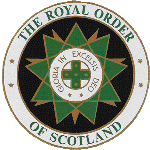
Royal Order comprises two Degrees, that of Heredom of Kilwinning and that of the Rosy Cross. Tradition tells us that the former was established in Judea, in Palestine, but whether at the time of the Crusaders of much earlier origin, tradition is silent.
The word “Heredom” has been variously interpreted, but the most obvious derivation is from the Hebrew word “Harodim”, meaning “The Rulers”, and the name of Kilwinning refers to the re-establishment of the Order by King Robert the Bruce at Kilwinning, where he presided as its first Grand Master.
The Degree of Heredom of Kilwinning is a peculiarly interesting Degree and full of instruction to Craft Masons, as in its lectures it explains the symbolism and teaching contained in the first three Degrees of what is sometimes referred to as St. John’s Masonry.
The Rosy Cross Degree, tradition takes its origin on the field of Bannockburn, on Summer St. John’s Day 1314, and was instituted by King Robert the Bruce, who having in the course of the battle for Scottish independence, received assistance from a body of sixty-three knights who may have been original Knights Templar and Freemasons. He conferred upon them as a reward for their services the civil rank of Knighthood. Each received a characteristic considered descriptive of his performance at Bannockburn. He granted them permission to confer the honor on such Scottish Freemasons professing the Christian religion as had shown themselves worthy of the honor. The number on whom the Knighthood might be conferred was limited to sixty-three, but in years, owing to the large number of worthy Freemasons who coveted this honor, the Grand Lodge of the Order, when it found it necessary to establish Provincial Grand Lodges elsewhere than in Scotland, granted each Provincial Grand Lodge permission to promote sixty-three Freemasons of the Degree of Heredom to the honor of Knighthood under the Grand Lodge. In some of the Provincial Grand Lodges where the members of Heredom number many hundreds, special powers have been given to increase the number of Knights of the Rosy Cross. This degree, as its name implies, deals more with the subject matter of the Rose Croix Degree of the Ancient and Accepted Scottish Rite than with that of Craft Masonry. The Degree of Knighthood can only be conferred in the Grand Lodge of the Royal Order, which has its seat in Edinburgh, or by special authority by a Provincial Grand Master or his deputy. This authority is purely personal to a Provincial Grand Master, and cannot be transmitted by him to his successors.
By the Constitution of the Royal Order, the King of Scots is its hereditary Grand Master, for whom at every meeting of the Order, wherever held, a vacant chair or throne must be placed at the right hand of the presiding officer. The acting head of the Order is the Deputy Grand Master and Governor, who appoints a Deputy Governor.
There are no reliable records tracing the history of the Order from its alleged revival in 1314 to the middle of the eighteenth century, when it appears to have flourished in France about the year 1735-40 under the adherents of the Jacobile Cause, who being refugees from Scotland practiced these Degrees no doubt for the purpose of maintaining a common bond of union among them in a foreign land. It is stated that in 1747 in a Charter which was in existence in 1840, granted by Prince Charles Edward Stuart to the Masonic Lodge at Arras, he described himself as Sovereign Grand Master of the Order of “Rose Croix de Herodim de Kilwinning”.
The ceremonies of the Degrees are peculiarly interesting, being different from those of other Degrees of Freemasonry, and part of the Ritual is rendered in an irregular versified rhyming form. The original French manuscript of the Ritual, rendered in that language, is in the possession of the Grand Lodge of the Order in Edinburgh.
It should be noted that from a historical viewpoint The Royal Order of Scotland as a Masonic System is Senior to all other Degrees & Orders with the exception of The first two Degrees of the Craft (Blue) Lodges. Documentary evidence exists in its archives indicating this Order was active as early as 1741.
Originally, membership in the Order was limited to Scotsmen or those of Scottish descent, but later the privilege was extended to Master Masons of other nationalities. The Order has now, besides Provincial Grand Lodges in Scotland and in England, Provincial Grand Lodges all over the world, including the United States of America where the Order is very highly prized, and is not conferred on any one who has not received either the Thirty-second Degree of the Ancient and Accepted Scottish Rite or the Order of the Temple, except by waiver from the Provincial Grand Master.
The Order is one which is, from its historical association, particularly interesting to Scotsmen, and each year on the 4th of July (old style), the anniversary of the day on which the Battle of Bannockburn was fought, the Grand Lodge of the Order, as well as some of the Provincial Grand Lodges, continue the ancient custom of the Order by holding a festival, at which the Toast to the Immortal Memory of King Robert the Bruce, the hero of Bannockburn and Restorer of the Order is proposed in an oration by one of the Brethren, and honored in silence. The Degrees of the Order are most beautiful and impressive, and inculcate the three great principles of Freemasonry – Brotherly Love, Relief and Truth.
There is evidence of an early Provincial Grand Lodge in the United States of America at Norfolk, Virginia, but there are no records available. The Provincial Grand Lodge of the U.S.A. was constituted on May 4, 1878. Sir Albert Pike was the first Provincial Grand Master and was appointed in 1877 and served until 1891.